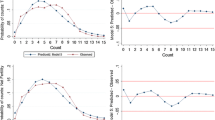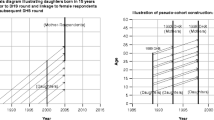Abstract
This article uses the Bangladesh famine of 1974 as a natural experiment to estimate the impact of intrauterine malnutrition on sex of the child and infant mortality. In addition, we estimate the impact of malnutrition on post-famine pregnancy outcomes. Using the 1996 Matlab Health and Socioeconomic Survey (MHSS), we find that women who were pregnant during the famine were less likely to have male children. Moreover, children who were in utero during the most severe period of the Bangladesh famine were 32 % more likely to die within one month of birth compared with their siblings who were not in utero during the famine. Finally, we estimate the impacts of the famine on subsequent pregnancy outcomes. Controlling for pre-famine fertility, we find that women who were pregnant during the famine experienced a higher number of stillbirths in the post-famine years. This increase appears to be driven by an excess number of male stillbirths.


Similar content being viewed by others
Notes
There are several other smaller differences between our studies. Razzaque et al. (1990) defined the period of the famine-born as July 1974 through June 1975 and compared the outcomes during that period with those during a famine-conceived period of July 1975–1976 and a non-famine period between July 1976 and March 1977. Our study uses a different definition of the famine—August 1974 to October 1975—based on the months when the price of rice was more than 50 % higher than the pre-famine price. Our study also uses a wider window of time as a control group and has other minor differences, such as our use of a multivariate logistic regression instead of a univariate one.
When the specific month of birth was not remembered or unavailable, fieldworkers often coded the birth as occurring in January. Thus, the data include an inaccurately large number of January births. The main specifications in this article are estimated with these January births included. However, all results (available upon request) are qualitatively robust to the exclusion of January births from the sample. In addition, the years 1970–1972 were also associated with bad crops, high food prices, and political turmoil. We estimated similar regressions in which we limited the sample to the years 1974–1980, effectively eliminating the war, earlier famine, and hardship from the control group; we found similar qualitative and quantitative results, which are available upon request.
Birth weight and access to prenatal care are potential channels through which in utero exposure to the famine may affect infant mortality. The results presented are similar in magnitude and significance when these variables are excluded.
We include a dummy variable for the villages where the Maternal and Child Health Family Planning would be present even though that project did not begin until 1978 to account for potential differences between these villages even before the project began. We also estimate regressions without including these dummy variables and find nearly identical results, which are available upon request. Season-of-birth dummy variables include whether the child was born during the monsoon season (June–October) or the dry winter season (November–February), with the omitted category being the pre-monsoon hot season (March–May). Infant deaths are significantly higher during the winter season, largely because of agricultural cycles.
This type of selection implies that women who choose to become pregnant during a famine are negatively selected. Based on observable measures, the descriptive statistics from Table 2 suggest the opposite: although the magnitude of the difference is not large, women who became pregnant during the famine were more educated and married spouses who were more educated, compared with women who avoided pregnancy.
References
Alamgir, M. (1980). Famine in South Asia: Political economy of mass starvation. Cambridge, MA: Oelgeschlager, Gunn and Hain.
Alamgir, M., & Salimullah. (1977). Famine, 1974: Political economy of mass starvation in Bangladesh: A statistical annexe. Dacca: Bangladesh Institute of Development Studies.
Almond, D. (2006). Is the 1918 influenza pandemic over? Long-term effects of in utero influenza exposure in the post-1940 U.S. population. Journal of Political Economy, 114, 672–712.
Almond, D., & Currie, J. (2011). Killing me softly: The fetal origin hypothesis. Journal of Economic Perspectives, 25, 153–172.
Almond, D., & Edlund, L. (2007). Trivers-Willard at birth and one year: Evidence from US natality data 1983–2001. Proceedings of the Royal Society B, 274, 2491–2496.
Almond, D., Edlund, L., Li, H., & Zhang, J. (2008). Long-term effects of early life development: Evidence from the 1959–1961 China famine. In T. Ito & A. Rose (Eds.), The economic consequences of demographic change in East Asia (pp. 321–345). Cambridge, MA: National Bureau of Economic Research.
Almond, D., & Mazumder, B. (2011). Health capital and the pre-natal environment: The effect of Ramadan observance during pregnancy. American Economic Journals: Applied Economics, 3(4), 56–85.
Anderson, R., & Bergstrom, S. (1998). Is maternal malnutrition associated with a low sex ratio at birth? Human Biology, 70, 1101–1106.
Bairagi, R. (1986). Food crisis, nutrition, and female children in rural Bangladesh. Population and Development Review, 12, 307–315.
Barker, D. J. (1990). The fetal and infant origins of adult disease. BMJ, 301, 1111.
Binswinger, H., & Rosenzweig, M. (1986). Behavioural and material determinants of production relations in agriculture. Journal of Development Studies, 22, 503–539.
Bulik, C. M., Sullivan, P. F., Fear, J. L., Pickering, A., Dawn, A., & McCullin, M. (1999). Fertility and reproduction in women with anorexia nervosa: A controlled study. Journal of Clinical Psychiatry, 60, 130–135.
Camacho, A. (2008). Stress and birth weight: Evidence from terrorist attack. American Economic Review, 98, 511–515.
Cameron, E. Z. (2004). Facultative adjustment of mammalian sex ratios in support of the Trivers-Willard hypothesis: Evidence for a mechanism. Proceedings of the Royal Society, 271, 1723–1728.
Choe, M. K., & Razzaque, A. (1990). Effect of famine on child survival in Matlab, Bangladesh. Asia-Pacific Population Journal, 5(2), 53–72.
Collins, S. (1995). The limit of human adaptation to starvation. Nature Medicine, 1, 810–814.
Davis, A. P. (1996). Targeting the vulnerable in emergency situations: Who is vulnerable? The Lancet, 348, 868–871.
Dyson, T. (1991). On the demography of South Asian famines—Part II. Population Studies, 45, 279–297.
Fauveau, V., & Chakraborty, J. (1994). Family planning and maternal and child health services in Matlab. In V. Fauveau (Ed.), Matlab: Women, children and health (Special Publication No. 35, pp. 89–107). Dhaka, Bangladesh: International Centre for Diarrhoeal Disease Research.
Hart, N. (1993). Famine, maternal nutrition and infant mortality: A re-examination of the Dutch Hunger Winter. Population Studies, 47, 27–46.
Huck, W. U., Labov, J. B., & Lisk, R. D. (1986). Food restricting young hamsters (Mesocricetus auratus) affects sex ratio and growth of sebsequent offspring. Biology of Reproduction, 35, 592–598.
India Famine Inquiry Commission. (1976). Report on Bengal. New York, NY: Arno Press.
Janowitz, B., Holtman, M., Hubacher, D., & Jamil, K. (1997). Can the Bangladeshi Family Planning Program meet rising needs without raising costs? International Family Planning Perspectives, 23, 116–121.
Joshi, S., & Schultz, P. T. (2007). Family planning as an investment in development: Evaluation of a program’s consequences in Matlab, Bangladesh (Economic Growth Center Discussion Paper No. 951). New Haven, CT: Yale University.
Kannisto, V., Christensen, K., & Vaupel, J. W. (1997). No increased mortality in later life for cohorts born during famine. American Journal of Epidemiology, 145, 987–994.
Katz, M., & Vollenhoven, B. (2000). The reproductive endocrine consequences of anorexia nervosa. British Journal of Obstetrics and Gynaecology, 107, 707–713.
Koenig, M. A., & D’Souza, S. (1986). Sex differences in childhood mortality in rural Bangladesh. Social Science & Medicine, 22, 15–22.
Kuhn, R. S. (2005). The determinants of family and individual migration: A case-study of rural Bangladesh (Research Program on Population Processes Working Paper POP2005-05). Boulder, CO: Institute of Behavioral Science.
Langsten, R. (1981). The effects of crises on differential mortality by sex in Bangladesh. Bangladesh Development Studies, 9(2), 75–96.
Lindeboom, M., Portrait, F., & van den Berg, G. J. (2010). Long-run effects on longevity of a nutritional shock early in life: The Dutch Potato Famine of 1846–1847. Journal of Health Economics, 29, 617–629.
Lumey, L. H., & Stein, A. D. (1997). Offspring birth weights after maternal intrauterine undernutrition: A comparison within sibships. American Journal of Epidemiology, 146, 810–819.
Mansour, H., & Rees, D. I. (2012). Armed conflict and birth weight: Evidence from the Al-Aqsa Intifada. Journal of Development Economics, 99, 190–199.
Meikle, D. B., & Drickamer, L. C. (1986). Food availability and secondary sex ratio variation in wild laboratory house mice (Mus musculus). Journal of Reproduction and Fertility, 78, 587–591.
Neugebauer, R., Hoek, H. W., & Susser, E. (1999). Prenatal exposure to wartime famine and development of antisocial personality disorder in early adulthood. Journal of the American Medical Association, 282, 455–462.
Painter, R. C., Rosenboom, T. J., & Bleker, O. P. (2005). Prenatal exposure to the Dutch famine and disease in later life: An overview. Reproductive Toxicology, 20, 345–352.
Pitt, M., & Khandker, S. (1998). The impact of group-based credit programs on poor households in Bangladesh: Does the gender of participants matter? Journal of Political Economy, 106, 958–996.
Rahman, O., Menken, J., Foster, A., Peterson, C. E., Khan, M. N., Kuhn, R., & Gertler, P. (1999). The 1996 Matlab Health and Socioeconomic Survey: Overview and user’s guide (Unrestricted Draft Series No. DRU-2018/1-NIA). Santa Monica, CA: RAND.
Razzaque, A. (1988). Effect of famine on fertility in an area of rural Bangladesh. Journal of Biosocial Science, 20, 287–294.
Razzaque, A., Alam, N., Wai, L., & Foster, A. (1990). Sustained effects of the 1974–5 famine on infant and child mortality in a rural area of Bangladesh. Population Studies, 44, 145–154.
Roseboom, T. J., van der Meulen, J. H. P., Osmond, C., Barker, D. J. P., Ravelli, A. C. J., & Bleker, O. P. (2001a). Adult survival after prenatal exposure to Dutch famine 1944–45. Paediatric and Perinatal Epidemiology, 16, 220–225.
Roseboom, T. J., van der Meulen, J. H. P., Ravelli, A. C., Osmond, C., Barker, D. H., & Bleker, O. P. (2001b). Effects of prenatal exposure to the Dutch famine on adult disease in later life: An overview. Twin Research, 4, 293–298.
Rosenfeld, C. S., & Roberts, R. M. (2004). Maternal diet and other factors affecting offspring sex ratio: A review. Biology of Reproduction, 71, 1063–1070.
Rosenzweig, M., & Wolpin, K. (1985). Specific experience, household structure, and intergenerational transfers: Farm family land and labor arrangements in developing countries. Quarterly Journal of Economics, 100(Suppl), 961–987.
Scott, S., Duncan, S. R., & Duncan, C. J. (1995). Infant mortality and famine: A study in historical epidemiology in Northern England. Journal of Epidemiology and Community Health, 49, 145–252.
Sen, A. (1981). Ingredients of famine analysis: Availability and entitlements. Quarterly Journal of Economics, 96, 433–464.
Stein, A. D., Zybert, P. A., & Lumey, L. H. (2004). Acute undernutrition is not associated with excess of females at birth in humans: The Dutch Hunger Winter. Proceedings of the Royal Society B, 271, S138–S141.
Stein, Z., & Susser, M. (1975). The Dutch Famine, 1944–1945, and the reproductive process. I. Effects on six indices at birth. Pediatric Research, 9, 70–76.
Trivers, R. L., & Willard, R. E. (1973). Natural selection and the ability to vary the sex ratio of offspring. Science, 179, 90–92.
United Nations Secretariat. (2003). World population prospects: The 2000 revision. New York, NY: United Nations. Retrieved from http://www.un.org/esa/population/publications/wpp2002/WPP2002-HIGHLIGHTSrev1.PDF
Acknowledgments
We are grateful to Daniel Rees, Angela Dills, and Martha Bailey for useful comments on an earlier version of this article.
Author information
Authors and Affiliations
Corresponding author
Rights and permissions
About this article
Cite this article
Hernández-Julián, R., Mansour, H. & Peters, C. The Effects of Intrauterine Malnutrition on Birth and Fertility Outcomes: Evidence From the 1974 Bangladesh Famine. Demography 51, 1775–1796 (2014). https://doi.org/10.1007/s13524-014-0326-5
Published:
Issue Date:
DOI: https://doi.org/10.1007/s13524-014-0326-5




